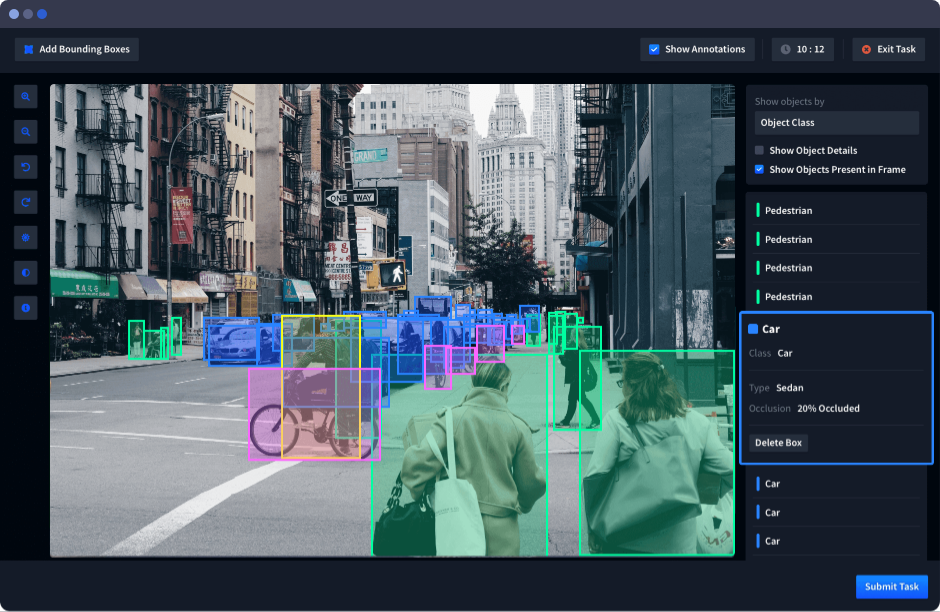What is data labeling?
Explore what data labeling can do for your AI initiatives, from optimizing operations to accelerating product development and making data-driven decisions with confidence. Everything you need to know before you engage with a data annotation company.
Table of Contents
What is data labeling? Machine learning (ML) has become a driving force in various industries, powered by high-quality annotated data.
However, many developers still have questions about processing quality data for their ML models.
Labeling data is a time and resource intensive task which is why it is often outsourced.
This article dives into what data annotation is, why we need it, how to label data, and lastly different types of data labeling services.
What is data labeling?
Data labeling is the process of annotating or tagging data to make it understandable and usable for machine learning (ML) algorithms. It involves adding metadata or labels to data points to indicate specific characteristics or attributes of the data.
Data labeling is a crucial step in supervised machine learning, where models are trained on labeled data to make predictions or classifications.
Types of data labeling for machine learning

1. Image annotation
Image data annotation is the process of adding labels, bounding boxes, or other metadata to images, making them understandable for machine learning.
It’s crucial for training models in tasks like image recognition and object detection.
2. Video annotation
Data annotation for videos involves the process of adding labels, tags, or metadata to video frames or segments.
This helps machine learning models understand and recognize objects, actions, or events within the video content.
Video annotation is crucial for tasks like video surveillance, action recognition, and autonomous vehicles, enabling these systems to interpret and respond to visual information accurately.
3. Audio annotation
Data annotation for audio involves the process of adding labels, transcriptions, or metadata to audio recordings, making them understandable for machine learning applications.
This annotation can include identifying spoken words, sounds, or music genres, enabling speech recognition, audio classification, and other audio-based tasks.
Accurate audio annotation is vital for improving the performance of speech-to-text systems, audio analysis, and voice assistants.

4. Text annotation
Data annotation for audio involves the process of adding labels, transcriptions, or metadata to audio recordings, making them understandable for machine learning applications.
This annotation can include identifying spoken words, sounds, or music genres, enabling speech recognition, audio classification, and other audio-based tasks.
Accurate audio annotation is vital for improving the performance of speech-to-text systems, audio analysis, and voice assistants.
5. Structured data annotation
Structured data annotation involves adding labels or metadata to structured datasets, such as tables, databases, or spreadsheets.
Annotations in structured data can include categorizing rows or columns, assigning data types to fields, and tagging individual entries with relevant information.
This annotation process facilitates data analysis, machine learning tasks, and the extraction of valuable insights from structured data sources.
Why do I need data labeling?
Data labeling is crucial because it provides the necessary context and structure for machine learning models to learn and make predictions.
Without labeled data, models lack the guidance to understand patterns and relationships within the data. It acts as a foundation for supervised learning, where models map input data to desired outputs based on labeled examples.
Data labeling ensures consistency and accuracy, enabling models to generalize from training data to real-world scenarios. It’s essential in diverse fields, such as healthcare, finance, and autonomous vehicles, where precision is paramount.
Furthermore, labeled data facilitates quality control by allowing for the evaluation of model performance and continuous improvement. It helps measure the accuracy, reliability, and effectiveness of machine learning models.
In addition, data labeling supports tasks like object detection, natural language processing, and sentiment analysis, making it applicable across a wide range of industries and applications.
All in all, data labeling is indispensable for training models, ensuring their accuracy, and driving advancements in AI across various domains.
How to label data
To label data, start by creating clear instructions (labeling guidelines) for annotators, specifying how to mark or describe key attributes or patterns in the data.
Provide annotators with training to ensure they understand the labeling criteria. Then, use dedicated annotation tools or software for efficiency.
Continuously monitor and review annotations to maintain accuracy and consistency.
Finally, organize and store the labeled data securely, adhering to privacy regulations when necessary.
If you’d like to learn more, check out our article on How to train data annotators.
What do data labeling tools do?
Data labeling tools are software applications designed to streamline and facilitate the process of adding annotations or labels to raw data.
These tools provide a user-friendly interface for annotators to apply labels, draw bounding boxes, or add metadata, depending on the labeling task.
They often offer features for image, text, audio, or video annotation, and some tools include automation capabilities like pre-defined templates or machine learning assistance to speed up the labeling process.
Data labeling tools also typically include quality control mechanisms to ensure the accuracy and consistency of annotations, making them essential for efficiently preparing labeled datasets for machine learning tasks.

Should I outsource data labeling?
Outsourcing data labeling can be cost-effective and efficient, allowing your organization to focus on core tasks while experts handle the labeling process.
It also provides access to a scalable workforce, reducing the time and resources needed for annotating large datasets.
If you’re considering outsourcing data labeling for your project but would first like to learn more, check out Why you should outsource data annotation for ML
